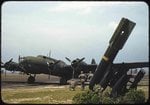Njaco
The Pop-Tart Whisperer
While searching for some pics of a particular B-17, I came across a Flickr site with some great pics including these of Y1B-17s.
Boeing B-17 Flying Fortress - Wikipedia, the free encyclopedia
On 17 January 1936, through a legal loophole, the Air Corps ordered 13 YB-17s (designated Y1B-17 after November 1936 to denote its special F-1 funding) for service testing. The YB-17 incorporated a number of significant changes from the Model 299, including more powerful Wright R-1820-39 Cyclone engines replacing the original Pratt Whitneys. Although the prototype was company-owned and never received a military serial (the B-17 designation itself did not appear officially until January 1936, nearly three months after the prototype crashed), the term "XB-17" was retroactively applied to the airframe and has entered the lexicon to describe the first Flying Fortress.
Between 1 March and 4 August 1937, 12 of the 13 Y1B-17s were delivered to the 2nd Bombardment Group at Langley Field in Virginia for operational development and flight tests. One suggestion adopted was the use of a pre-flight checklist to avoid accidents such as that which befell the Model 299. In one of their first missions, three B-17s, directed by lead navigator Lieutenant Curtis LeMay, were sent by General Andrews to "intercept" and photograph the Italian ocean liner Rex 610 miles (980 km) off the Atlantic coast. The mission was successful and widely publicized. The 13th Y1B-17 was delivered to the Material Division at Wright Field, Ohio, to be used for flight testing.
A 14th Y1B-17 (37-369), originally constructed for ground testing of the airframe's strength, was upgraded and fitted with exhaust-driven turbochargers. Scheduled to fly in 1937, it encountered problems with the turbochargers, and its first flight was delayed until 29 April 1938. The aircraft was delivered to the Army on 31 January 1939. Once service testing was complete, the Y1B-17s and Y1B-17A were redesignated B-17 and B-17A respectively to signify the change to operational status.
I'll post more as I find them.
Boeing B-17 Flying Fortress - Wikipedia, the free encyclopedia
On 17 January 1936, through a legal loophole, the Air Corps ordered 13 YB-17s (designated Y1B-17 after November 1936 to denote its special F-1 funding) for service testing. The YB-17 incorporated a number of significant changes from the Model 299, including more powerful Wright R-1820-39 Cyclone engines replacing the original Pratt Whitneys. Although the prototype was company-owned and never received a military serial (the B-17 designation itself did not appear officially until January 1936, nearly three months after the prototype crashed), the term "XB-17" was retroactively applied to the airframe and has entered the lexicon to describe the first Flying Fortress.
Between 1 March and 4 August 1937, 12 of the 13 Y1B-17s were delivered to the 2nd Bombardment Group at Langley Field in Virginia for operational development and flight tests. One suggestion adopted was the use of a pre-flight checklist to avoid accidents such as that which befell the Model 299. In one of their first missions, three B-17s, directed by lead navigator Lieutenant Curtis LeMay, were sent by General Andrews to "intercept" and photograph the Italian ocean liner Rex 610 miles (980 km) off the Atlantic coast. The mission was successful and widely publicized. The 13th Y1B-17 was delivered to the Material Division at Wright Field, Ohio, to be used for flight testing.
A 14th Y1B-17 (37-369), originally constructed for ground testing of the airframe's strength, was upgraded and fitted with exhaust-driven turbochargers. Scheduled to fly in 1937, it encountered problems with the turbochargers, and its first flight was delayed until 29 April 1938. The aircraft was delivered to the Army on 31 January 1939. Once service testing was complete, the Y1B-17s and Y1B-17A were redesignated B-17 and B-17A respectively to signify the change to operational status.
I'll post more as I find them.







